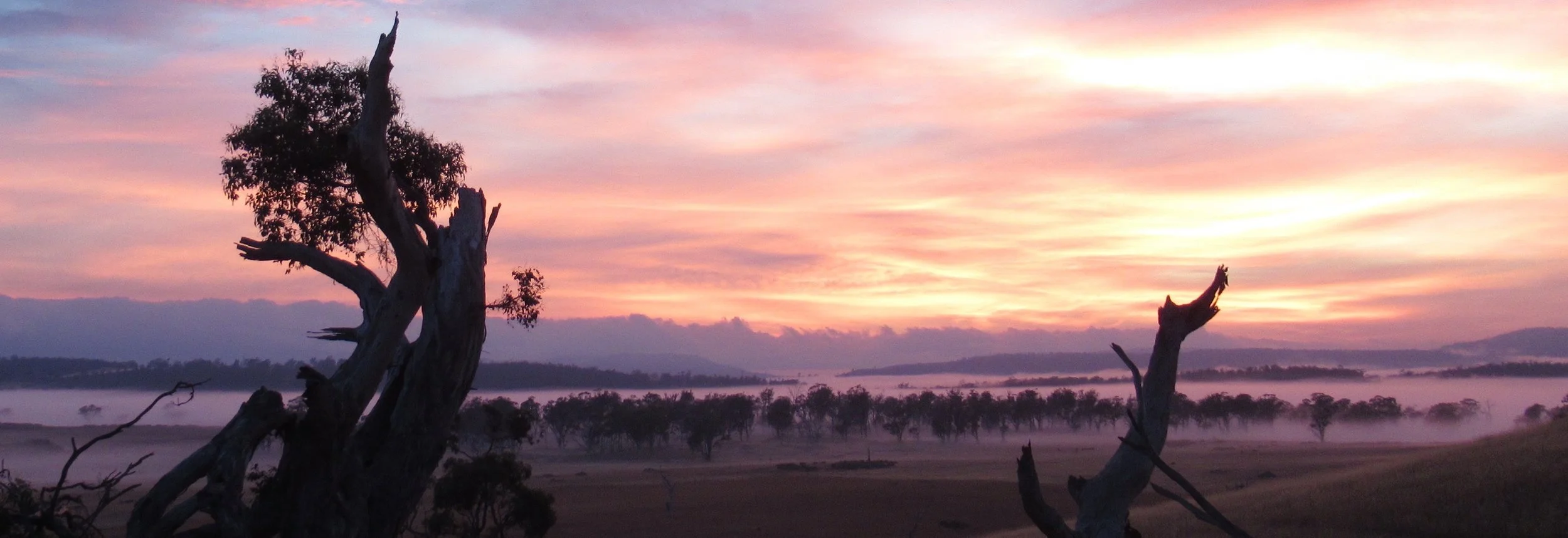I would like to start by acknowledging the traditional owners of the land in this part of lutruwita (Tasmania): the tyerrernotepanner (pronounced “cheranotipana") marwemairer, peenrymairmener and rolemairre language groups. These clans were nomadic through the central plateau and the east coast of lutruwita. Although my initial research has not revealed much more than this basic information about the clans, I’ve come across some modern history of Aboriginal communities in Tasmania, described in what are called Healthy Country Plans, as I discuss below. I’ll keep digging on the early history, recognising the limitations of the internet for serious scholarship.
When I first took my new stockman Davey Carnes to the top part of the farm, where the rich dolerite soil was mostly too shallow to be plowed up, and native plants still thrived, he said to me with considerable satisfaction in voice, “Ah. This is healthy country.” At the time, I had no idea what he meant. I do now, since it is precisely that biodiversity that maintains the excellent health of WGW sheep. But I was struck by Davey’s comment at the time, at least as much for the pleasure in his voice as the actual words, and I’ve been reminded of them many times since my sheep have become locally adapted to this bit of healthy country.
So, when I recently came across the idea of Healthy Country in a different, but related context, my ears immediately pricked up. At a workshop on climate change and the environment, a fellow participant referred to work he does called Healthy Country Planning. This is a technique from what is known as the Open Standards for the Practice of Conservation. Open Standards have been developed to assist community groups to create and implement plans for their landscape. The methodology resides in the public domain, and has been used with considerable success by Aboriginal groups throughout Australia.
There are currently seven Healthy Country Plans in Tasmania, with different time frames and level of detail: preminghana; trawtha makuminya; lungtalanana; Babel and Big Dog Islands; truwana/Cape Barren Island; larapuna; and wybalena. The plans have been developed by the Tasmanian Aboriginal Centre (TAC) with the assistance of Conservation Management Pty Ltd , a certified “Social Enterprise” that specialises in conservation program support with an emphasis on working with Aboriginal communities all across Australia. A Social Enterprise is an organisation that applies commercial strategies to maximise improvements in human and environmental well-being rather than maximizing profits for external shareholders.
trawtha makuminya is the Healthy Country Plan area closest to White Gum Wool farm, both geographically and in terms of landscape, though it is at a higher elevation and encompasses a much larger and more diverse area.
Healthy Country methodology begins with the group defining what they want the future to look like—their vision. The group then considers both the things they want to look after and the threats facing those things. Projects are developed with defined actions to enhance the things of value and reduce the threats. A monitoring system is established with a feedback loop into the projects to allow for adaptation over time as the group learns more about their country and effect of the actions they are taking.
The trawtha makuminya Healthy Country Plan 2015 to 2020 was developed by representatives of the Tasmanian Aboriginal community, supported by the Tasmanian Aboriginal Centre (TAC). The vision for trawtha makuminya is:
trawtha makuminya is a place
to create story
to develop an understanding
of its history, heritage values, use and environment, for traditional and new practices
The plan identifies 7 target building blocks for making this country healthy, and assesses the status of each by identifying both assets (values) and threats. The healthiest building block (or “target/value”) is Waterways and Wetlands because “three rivers traverse trawtha makuminya; the Nive, Pine and Little Rivers, tributaries of the Derwent River. These rivers are in largely pristine condition and flow freely throughout the dry summers.” There are several wetlands habitats that have special conservation significants, notably alpine sphagnum peatlands, which are endangered nationally and are rare in Tasmania.
The least healthy target/value is Financial Opportunities: “trawtha makuminya is an opportunity for the community to explore options for a more independent economic base. For the community, being able to move to greater self-determination and reduce reliance on government is essential.”
In between are targets like: Birds and Mammals of Conservation Significance (Good); Community Use (Fair); Cultural Places, Heritage and Resources (Good); Grasslands and Surrounding Forests (Good); and tunapri: “tunapri is an Aboriginal word that means ‘to know or to understand’. Knowledge and understanding are important elements in the connection Aboriginal people have with the land. Aboriginal people traditionally had an intimate knowledge and understanding of their environment that came from living closely with nature and through stories passed down from generation to generation. Modern Aboriginal people have had to adapt to living in an environment in which we have been dispossessed of our lands and where foreign cultures and ways of life have been forced upon us.”
trawtha makuminya Healthy Country Planning resonates for me not least because it encompasses all of the values and attributes of the land in a way that acknowledges interdependence and linkages, seeking to improve the capacity of the landscape to support life, health and happiness.




